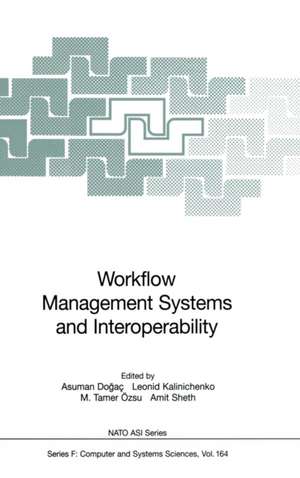Workflow Management Systems and Interoperability: NATO ASI Subseries F:, cartea 164
Editat de Asuman Dogac, Leonid Kalinichenko, Tamer Özsu, Amit Shethen Limba Engleză Hardback – 17 sep 1998
| Toate formatele și edițiile | Preț | Express |
|---|---|---|
| Paperback (1) | 657.83 lei 6-8 săpt. | |
| Springer Berlin, Heidelberg – 8 oct 2012 | 657.83 lei 6-8 săpt. | |
| Hardback (1) | 664.44 lei 6-8 săpt. | |
| Springer Berlin, Heidelberg – 17 sep 1998 | 664.44 lei 6-8 săpt. |
Din seria NATO ASI Subseries F:
- 20%
 Preț: 650.27 lei
Preț: 650.27 lei - 20%
 Preț: 668.55 lei
Preț: 668.55 lei - 20%
 Preț: 992.44 lei
Preț: 992.44 lei - 18%
 Preț: 1239.19 lei
Preț: 1239.19 lei - 20%
 Preț: 1928.45 lei
Preț: 1928.45 lei - 20%
 Preț: 654.37 lei
Preț: 654.37 lei - 18%
 Preț: 1234.00 lei
Preț: 1234.00 lei - 20%
 Preț: 709.78 lei
Preț: 709.78 lei - 20%
 Preț: 656.03 lei
Preț: 656.03 lei - 18%
 Preț: 1854.94 lei
Preț: 1854.94 lei - 20%
 Preț: 374.97 lei
Preț: 374.97 lei - 20%
 Preț: 991.94 lei
Preț: 991.94 lei - 20%
 Preț: 671.02 lei
Preț: 671.02 lei - 20%
 Preț: 1925.96 lei
Preț: 1925.96 lei - 20%
 Preț: 994.73 lei
Preț: 994.73 lei -
 Preț: 389.49 lei
Preț: 389.49 lei - 20%
 Preț: 657.99 lei
Preț: 657.99 lei - 20%
 Preț: 655.20 lei
Preț: 655.20 lei - 18%
 Preț: 1225.31 lei
Preț: 1225.31 lei - 18%
 Preț: 952.09 lei
Preț: 952.09 lei - 20%
 Preț: 332.06 lei
Preț: 332.06 lei - 20%
 Preț: 1284.47 lei
Preț: 1284.47 lei - 20%
 Preț: 644.81 lei
Preț: 644.81 lei -
 Preț: 395.85 lei
Preț: 395.85 lei - 18%
 Preț: 1221.07 lei
Preț: 1221.07 lei - 15%
 Preț: 643.34 lei
Preț: 643.34 lei - 20%
 Preț: 645.47 lei
Preț: 645.47 lei - 20%
 Preț: 1282.98 lei
Preț: 1282.98 lei - 20%
 Preț: 656.36 lei
Preț: 656.36 lei - 20%
 Preț: 1283.31 lei
Preț: 1283.31 lei - 20%
 Preț: 1924.15 lei
Preț: 1924.15 lei - 20%
 Preț: 362.24 lei
Preț: 362.24 lei
Preț: 664.44 lei
Preț vechi: 830.55 lei
-20% Nou
Puncte Express: 997
Preț estimativ în valută:
127.14€ • 133.36$ • 105.84£
127.14€ • 133.36$ • 105.84£
Carte tipărită la comandă
Livrare economică 01-15 aprilie
Preluare comenzi: 021 569.72.76
Specificații
ISBN-13: 9783540644118
ISBN-10: 3540644113
Pagini: 548
Ilustrații: XVII, 526 p.
Dimensiuni: 155 x 235 x 35 mm
Greutate: 0.94 kg
Ediția:1998
Editura: Springer Berlin, Heidelberg
Colecția Springer
Seria NATO ASI Subseries F:
Locul publicării:Berlin, Heidelberg, Germany
ISBN-10: 3540644113
Pagini: 548
Ilustrații: XVII, 526 p.
Dimensiuni: 155 x 235 x 35 mm
Greutate: 0.94 kg
Ediția:1998
Editura: Springer Berlin, Heidelberg
Colecția Springer
Seria NATO ASI Subseries F:
Locul publicării:Berlin, Heidelberg, Germany
Public țintă
ResearchCuprins
Workflow Management: State of the Art Versus State of the Products.- 1. Introduction.- 1.1 Background.- 1.2 Workflow Systems.- 2. Workflow Products.- 2.1 Current Status.- 2.2 Industry Trends.- 3. Workflow Research.- 3.1 Transactional Workflow.- 3.2 Distributed Workflow Execution.- 3.3 Dynamic Workflow.- 4. Conclusions.- A Distributed Workflow and Product Data Management Application for the Construction of Large Scale Scientific Apparatus.- 1. Introduction.- 2. Background.- 3. General Architecture and Design.- 4. Data Distribution Philosophy.- 5. Workflow Management in CRISTAL.- 6. Workflow System Design.- 7. Coping with Dynamic Change.- 8. Conclusions and Project Status.- Workflow Applications to Research Agenda: Scalable and Dynamic Work Coordination and Collaboration Systems.- 1. Introduction.- 2. Agenda for Current and Future Research.- 3. Application Driven Motivation and Requirements.- 3.1 Scalability.- 3.2 Adaptive and Dynamic Workflows.- 3.3 Integral Support for Collaboration.- 4. METEOR2 WFMS and its Support for Scalability.- 4.1 Workflow Design and Application Building in METEOR2.- 4.2 The Runtime Code Generator.- 4.3 METEOR2 Runtime Support System.- 4.4 The ORBWork Workflow Enactment System.- 4.5 Scalability of ORBWork.- 5. New Challenges to Support Dynamic and Collaborative Work.- 5.1 Work Coordination and Collaboration System.- 5.2 WCCS Design.- 5.3 WCCS Architecture.- 5.4 Work Coordination and Collaboration Engine.- 6. Conclusions.- Design and Implementation of a Distributed Workflow Management System: METUFIow.- 1. Introduction.- 2. The Process Model and the METUFIow Definition Language:.- MFDL.- 3. Guard Generation for Distributed Scheduling.- 3.1 Semantics of the Block Types Using ACTA Formalism.- 3.2 Guard Construction Steps.- 4. METUFIow Architecture.-5. Guard Handlers in METUFIow.- 6. Task Handling in METUFIow.- 7. Worklist Management in METUFIow.- 8. History Management in METUFIow.- 9. OTS Based Transaction Manager.- 10. Correctness Issues in METUFIow.- 10.1 Concurrency Control in METUFIow.- 10.2 Future Considerations for Concurrency Control in METUFIow.- 11. Conclusions.- HP Workflow Research: Past, Present, and Future.- 1. Introduction.- 2. Stage 1: Advanced Feature Enhancements.- 3. Stage 2: Enterprise Business Process Management System.- 3.1 The Requirements.- 3.2 OpenPM Overview.- 3.3 OpenPM Application Development Facilities.- 3.4 An Application Example.- 4. Stage 3: Internet-Based Service Process Management System.- 4.1 FlowJet Overview.- Reducing Escalation-Related Costs in WFMSs.- 1. Introduction.- 2. System Model.- 2.1 Workflow Schema.- 2.2 Deadlines and Escalations.- 2.3 Assumptions.- 3. Dynamic Deadline Adjustment (DDA).- 4. Preemptive Escalation.- 5. Experimental Evaluation.- 5.1 Simulation Model.- 5.2 Experimental Setup.- 5.3 Simulation Results.- 6. Related Work.- 7. Conclusions.- The Workflow Management System Panta Rhei.- 1. Introduction.- 2. The Concepts of Panta Rhei.- 2.1 Classification of Workflows.- 2.2 Basic Concepts.- 2.3 Additional Features.- 2.4 Open Architecture.- 3. Workflow Description Language.- 3.1 Workflow Specification.- 3.2 Execution of WDL.- 4. Architecture and Implementation.- 5. Conclusions.- The WASA Approach to Workflow Management for Scientific Applications.- 1. Introduction.- 2. Workflow Modeling.- 2.1 Workflow Modeling in Business Applications.- 2.2 Workflow Modeling in Scientific Applications.- 2.3 Case Study: Scientific Workflows in Molecular Biology.- 3. Dynamic Change Operations.- 3.1 Anticipated Dynamic Change.- 3.2 Ad-hoc Dynamic Change.- 3.3 Related Work on Dynamic Change.- 4. The WASA Architecture.- 4.1 The WASA Layers.- 5. The WASA Prototype.- 5.1 General Considerations.- 5.2 System Architecture.- 6. Conclusions and Future Work.- Security Enforcement in Activity Management Systems.- 1. Introduction.- 1.1 Related Work.- 2. Secure CapBasED-AMS.- 2.1 Architecture of Secure CapBasED-AMS.- 3. Security Requirements for Activity Specification and Decomposition.- 3.1 Security Control in Activity Specification.- 3.2 Security Constraints Specification.- 4. Framework for Activity Execution.- 4.1 Activity Graph.- 4.2 ECA Rules.- 4.3 Activity Coordinator.- 4.4 Communication Between the Activity Coordinator and PSAs.- 4.5 Task and Event Logging.- 4.6 Exception Condition Handling and Error Recovery.- 5. Security Enforcement During Task Execution.- 5.1 Security Policy Decider and Secure PSA.- 5.2 Enforcement of Task Oriented Modeling of Security.- 6. Open Problems and Summary.- Towards a Platform for Distributed Application Development.- 1. Introduction.- 2. Motivation.- 2.1 Application Example.- 2.2 Software Solutions.- 2.3 Kernel Functionality for Distributed Systems.- 3. The OPERA Kernel.- 3.1 Architecture.- 3.2 Process Management: Model.- 3.3 Transactional Execution Guarantees.- 3.4 Availability and Scalability.- 3.5 Externalized Database Functionality.- 4. Application Examples.- 4.1 High-Level Object Management (HLOM).- 4.2 Distributed Object Management (DOM).- 5. Conclusions.- The Integration of Workflow Systems and Collaboration Tools.- 1. Introduction.- 2. Concerns and Theoretical Foundations.- 2.1 Coordination Versus Collaboration.- 2.2 The Situated Nature of Work.- 2.3 Organizational Structures and Flows.- 2.4 Empirical Evidence.- 3. Orchestra: a Testbed Environment.- 3.1 Objectives.- 3.2 Participants and Activities.- 4. Workflow Systems and Technology.- 4.1 A Sample of Workflow Systems.- 4.2 Groupware Environments and Workflow Support Mechanisms.- 4.3 Workflow Modeling Approaches.- 4.4 The Workflow Management Coalition.- 5. Collaboration Approaches and Technologies.- 5.1 Collaboration Technology.- 5.2 Techniques for Group Decision and Collaboration.- 5.3 Decision Models.- 6. The Integrative Approaches.- 6.1 Identifying Exceptions.- 6.2 Collaboration as a Handler for Coordination Problems.- 6.3 Beyond Exceptions.- 7. Conclusions.- Interoperability in Large-Scale Distributed Information Delivery Systems.- 1. Introduction.- 2. Architectural Issues.- 2.1 Multidatabase-Based Paradigm.- 2.2 Mediator-Based Paradigm.- 3. Technical Issues.- 3.1 Data Delivery Protocols.- 3.2 Data Delivery Modes.- 3.3 Data Delivery Frequency.- 3.4 General Remarks.- 4. Overview of Some Existing Projects.- 4.1 Broadcast Disks Approach to Information Dissemination.- 4.2 Carnot.- 4.3 DIOM.- 4.4 DISCO.- 4.5 InfoSleuth.- 4.6 MIND.- 4.7 TSIMMIS.- 4.8 Comparison with Respect to Data Delivery Capabilities.- 5. Enabling Technology for Interoperability.- 5.1 CORBA.- 5.2 COM/OLE.- 6. AURORA and its Application to Electronic Commerce.- 6.1 A Motivating Example:Virtual Catalogs in Electronic Commerce.- 6.2 Homogenization and Integration Mediators:A 2-tier Mediation Model.- 6.3 AURORA Mediators as Distributed Components.- 6.4 AURORA Mediator Development Workbench.- 6.5 Homogenization Mediators.- 6.6 AURORA Integration Mediators.- 6.7 Constructing Virtual Catalogs with AURORA.- 7. Conclusion.- Enterprise-Wide Workflow Management Based on State and Activity Charts.- 1. Introduction.- 2. Requirements on Workflow Specification Methods.- 3. Formal Methods for Workflow Specification.- 4. Workflow Specification with State and Activity Charts.- 4.1Introduction to State and Activity Charts.- 4.2 Design Methodology for Workflow Specifications.- 5. Utilizing Tools for Formal Verification.- 5.1 Workflow Properties.- 5.2 Specification of Workflow Properties.- 5.3 Model Checking.- 6. Distributed Workflow Execution.- 6.1 Partitioning of State and Activity Charts.- 6.2 Correctness of the Partitioning.- 6.3 Synchronization.- 6.4 Fault Tolerance.- 7. Conclusions.- Transactional Support for Cooperative Applications.- 1. Introduction.- 2. Transactional Support for Cooperative Applications.- 2.1 Characteristics of Cooperative Applications.- 2.2 Motivating Example.- 2.3 Requirements for a Cooperative Transaction Model.- 2.4 Approaches to Support Cooperative Work.- 3. Towards a Cooperative Transaction Model.- 3.1 Semantics-Based Approaches.- 3.2 Check-out/Check-in, Versioning, and Workspaces.- 3.3 Split/Join Transactions and Delegation.- 3.4 Group-Oriented Approaches and Transactional Workflow.- 4. The TRANSCOOP Approach.- 4.1 Overview of the COACT Transaction Model.- 4.2 Formalization of the COACT Transaction Model.- 4.3 Example of History Merging.- 4.4 Organizing the Work Process.- 4.5 Prototype Implementation.- 4.6 Discussion and Relationship to Other Transaction Models.- 5. Conclusions.- Migrating Workflows.- 1. Introduction.- 2. Migrating Workflow Model.- 3. Migrating Workflow - An Example.- 4. Enactment Mechanisms for the Migrating Workflows.- 4.1 Execution System Guarantees.- 4.2 Architectural Considerations.- 4.3 Security Considerations.- 4.4 User Interfaces.- 4.5 Networking Infrastructure.- 5. Workflow Administration Issues.- 5.1 Process Modeling.- 5.2 Workflow Specification.- 5.3 Administration of Migrating Workflows.- 6. Discussion and Summary.- Technology and Tools for Comprehensive Business Process Lifecycle Management.- 1. Introduction.- 2. Characterizing Business Processes.- 3. Traditional Business Process Lifecycle Management.- 3.1 Capturing Process Definition.- 3.2 Reengineering a Process.- 3.3 Implementing a Process.- 3.4 Performing Continuous Process Improvement.- 4. Technology and Tools for Business Process Lifecycle Management.- 4.1 Business Process Modeling Technology and Tools.- 4.2 Workflow Management Technology and Systems.- 4.3 Interoperability Between BPMTs and WFMSs.- 5. Role of BPMT and WFMS Technology.- in the Business Process Lifecycle.- 5.1 Capturing Process Definition.- 5.2 Reengineering a Process.- 5.3 Implementing a Process.- 5.4 Performing Continuous Process Improvement.- 6. Evaluation of Current Business Process Modeling Technology.- 6.1 Business Process Models and Methodologies.- 6.2 Business Process Analysis.- 6.3 Business Process Simulation.- 6.4 Business Process Evaluation Reports and Documentation.- 7. Evaluation of Current Workflow Management Technology.- 7.1 Workflow Model.- 7.2 Dataflow.- 7.3 Workflow Process Definition Tools.- 7.4 Analysis, Simulation, and Animation Tools.- 7.5 Workflow Monitoring and Tracking Tools.- 7.6 Basic WFMS Infrastructure: Architecture, GUIs, and APIs.- 7.7 Advanced WFMS Infrastructure:Distribution, Scalability, and Component Redundancy.- 7.8 Interoperability Among WFMSs and Heterogeneous Applications.- 7.9 Concurrency Control, Recovery, and Advanced Transactions.- 8. Evaluation of Current BPMTs and WFMSs Integration.- 8.1 Loose Integration.- 8.2 Tight Integration.- 8.3 Reverse Integration.- 9. Critical Success Factors and Conclusion.- Recent Trends in Workflow Management Products, Standards and Research.- 1. Introduction.- 2. Market Trends and Business Considerations.- 3. Workflow Standards.- 4. Technical Trends.- 5. Research Projects.- 6. Conclusions.- Kerem - Reasoning About the Design of Partially Cooperative Systems.- 1. Introduction and Motivation.- 1.1 Partially Cooperative Systems.- 1.2 The Need for Reasoning.- 1.3 Outline.- 2. The Modeling Tool.- 2.1 The Basic Primitives.- 2.2 The Event Perspective.- 2.3 The Task Perspective.- 2.4 The Entity Perspective.- 2.5 The Actor Perspective.- 2.6 An Example.- 3. Reasoning About a Design Model.- 3.1 Diagnostics.- 3.2 Change Evaluation.- 3.3 Query System.- 4. Conclusion.- 4.1 Related Work.- 4.2 Concluding Remarks.- Workflow Technologies Meet the Internet.- 1. Introduction.- 2. Open Workflow Clients.- 3. Workflow Component Servers.- 4. A Transactional Model for Cooperative Business Processes.- 5. Conclusions.- Workflow Reuse and Semantic Interoperation Issues.- 1. Introduction.- 2. Related Research and Technological Developments.- 3. Conventional Versus Component-Based Information Systems Development Life Cycles.- 4. Semantic Interoperation Reasoning Approach.- 4.1 The SIR Framework Models.- 4.2 Design with Reuse.- 5. Specification Refinement.- 6. Type Specification Reuse and Compositions.- 6.1 Most Common Reduct.- 6.2 Process of Common Reduct Detection.- 6.3 Construction of Concretizing Types and Views.- 7. Ontological Relevance of Specifications.- 7.1 Tight Ontological Relevance.- 7.2 Loose Ontological Relevance.- 8. A Uniform Script-Based Multiactivity Framework.- 8.1 An Overview of the Relevant SYNTHESIS Language Features.- 8.2 Script Types.- 8.3 Capabilities of the Canonical Model.- 8.4 An Example of a Funding Agency Multiactivity Specification.- 8.5 Pre-existing Workflow Specifications.- 9. Workflow Design with Reuse.- 9.1 An Introduction into the Basic Process Algebra with Iteration.- 9.2 Script Processes.- 9.3 Refinement of Scripts.- 9.4 Script Type Reducts.- 9.5 Process of a Script Design with Reuse.- 9.6 Example of the Most Common Reduct Identification.- 10. Conclusion.- A. Definition of a Script Type.- B. Interpretation of Stallware in the Canonical Workflow Model.- C. Interpretation of IBM FlowMark in the Canonical Workflow Model.- References.
Caracteristici
First book on the topic Leading researchers review and discuss current state-of-the-art and recent developments in workflow systems













